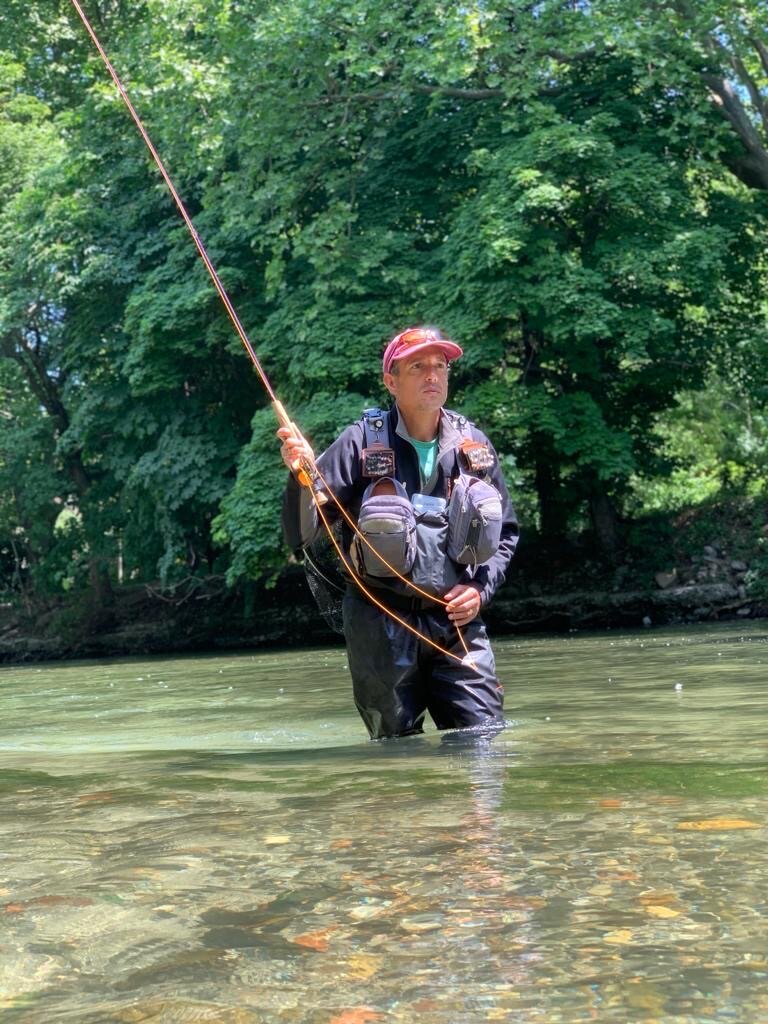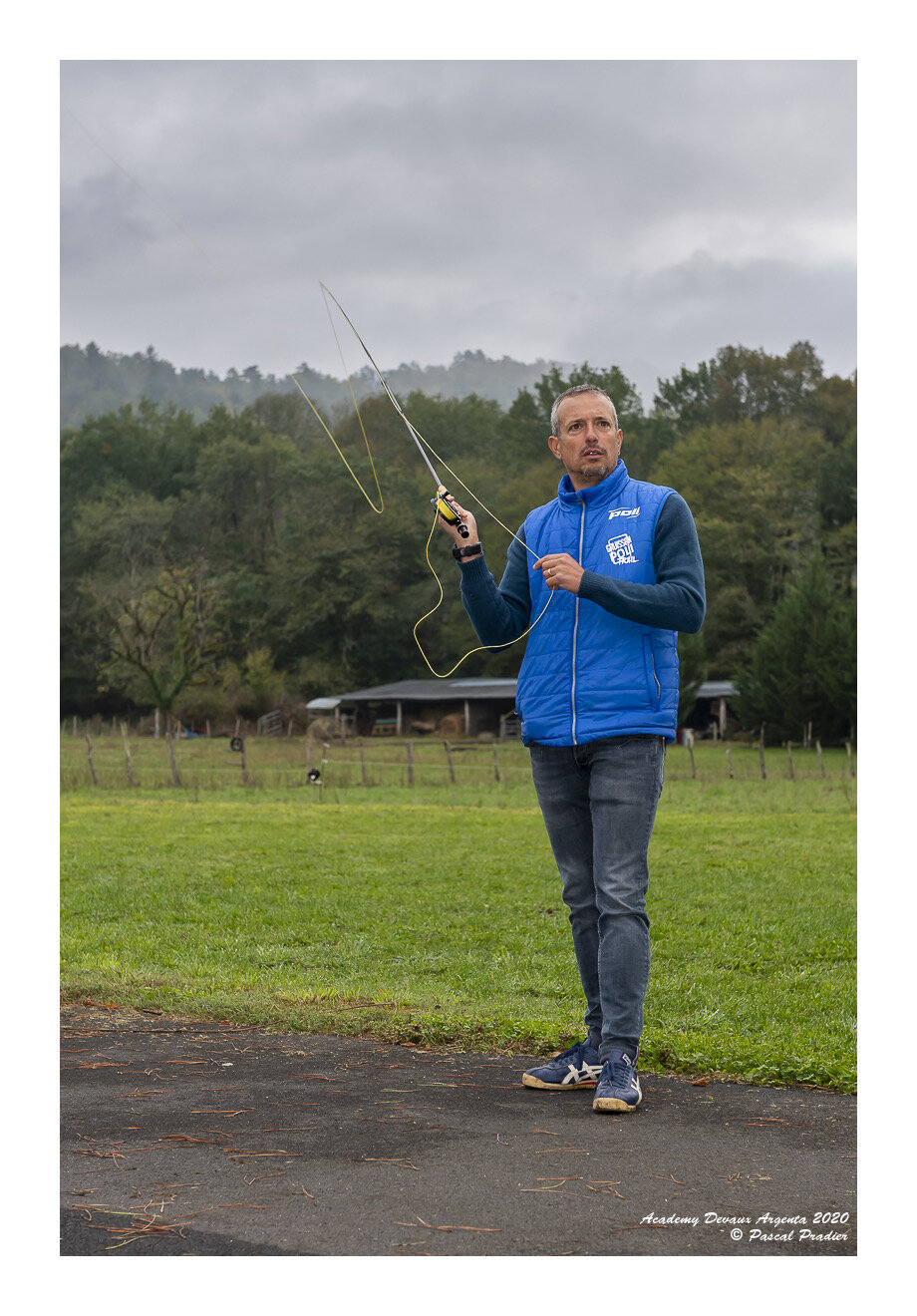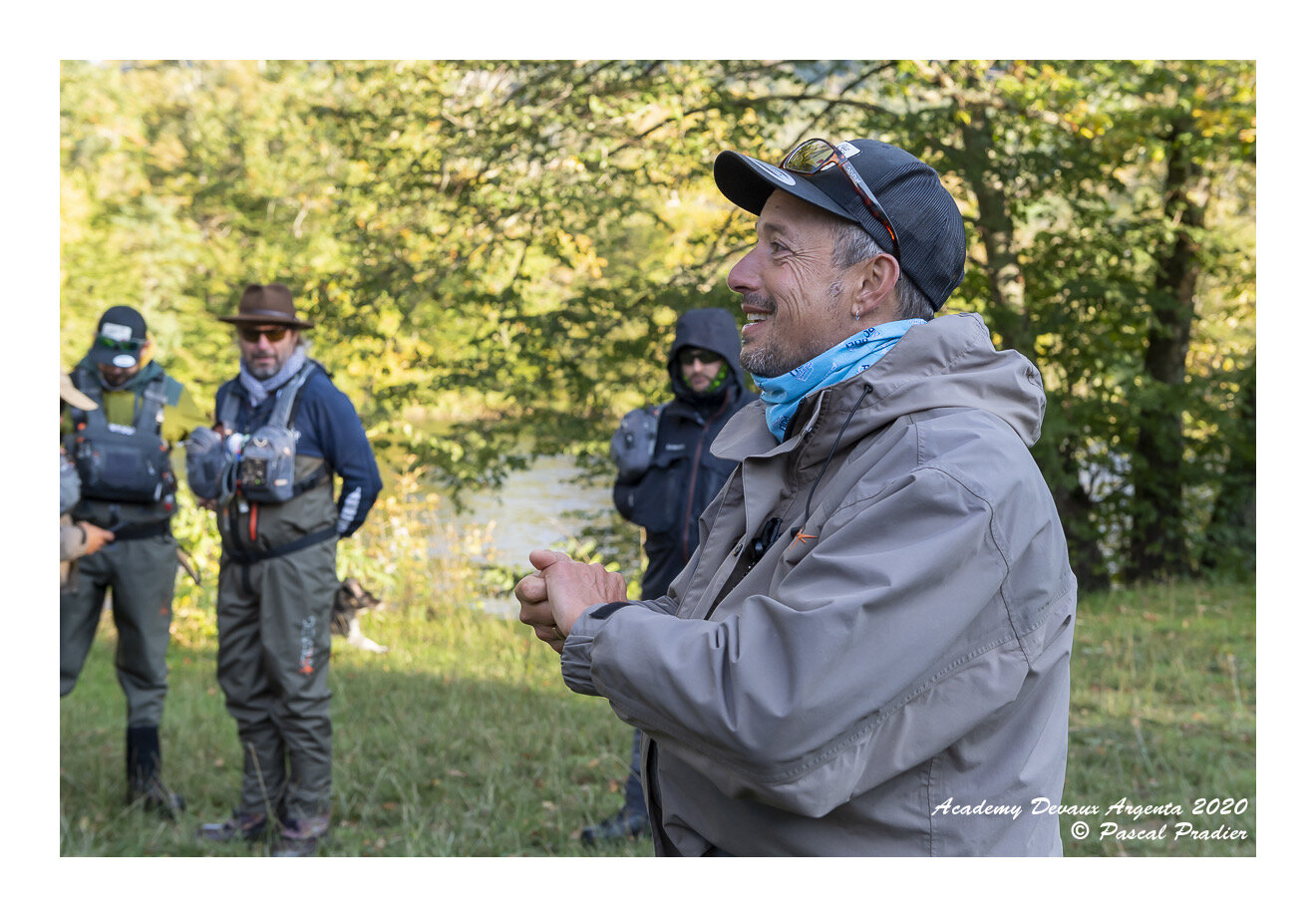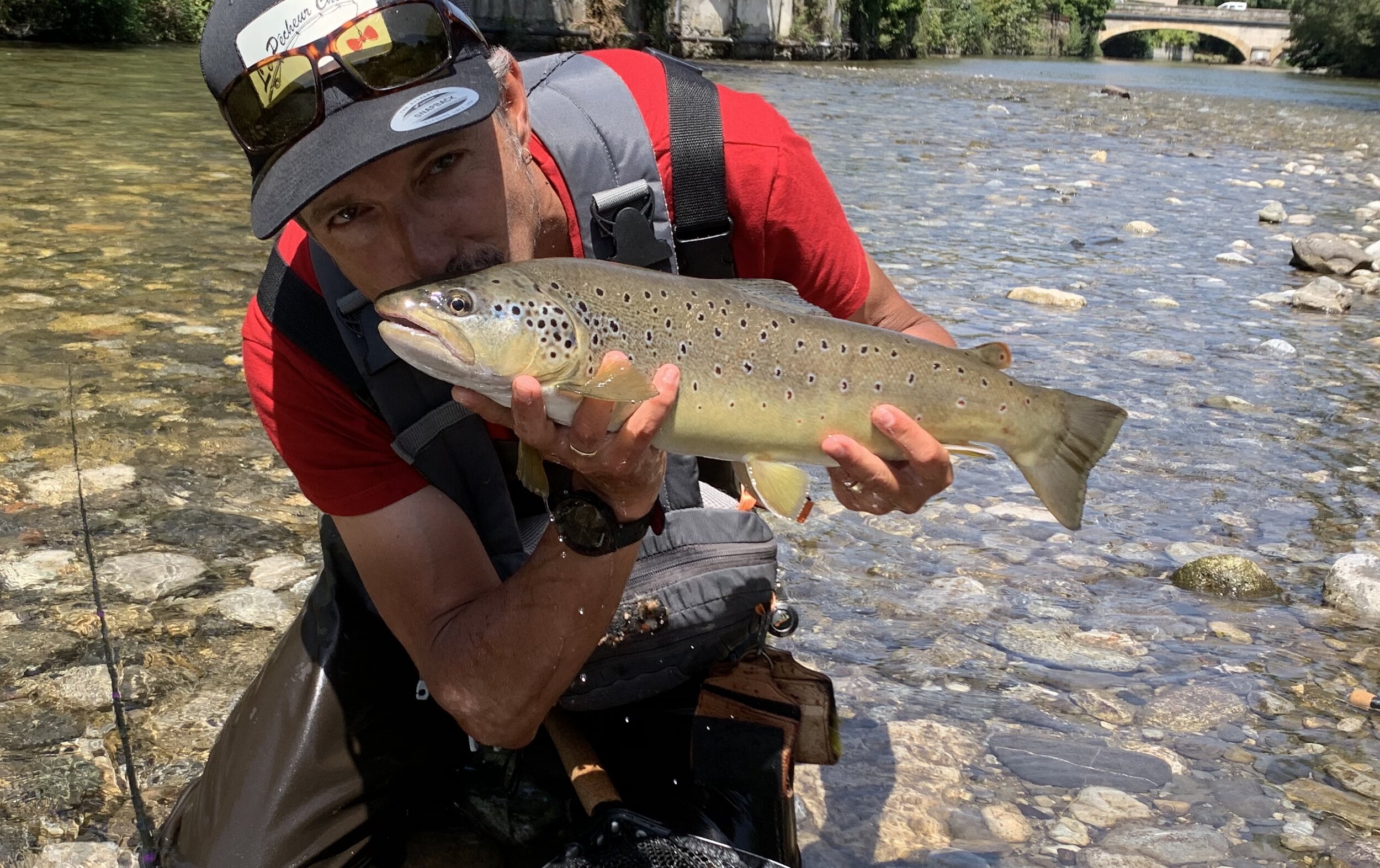
Yannick Rivière
Translation to English Malik Mazbouri simfly.ch
1 Choice of equipment Rods, reels, fly lines, fly floatants, clothes, glasses and other useful items.
The choice of the basic gear is essential. This choice has a direct impact on fishing comfort and comfort has an impact on the quality of fishing.
I choose the rod according to the technique I wish to practice. When I fish the dry with the "Pyrenean" technique called "rustic minimalist" — which places only the fly on the water thanks to the important lever of the rod — I choose a 10 foot rod with a mild progressive action that I combine with a DT3 line on a semi-automatic reel, and a classic decreasing leader. When I want to take advantage of the fun side of the rod, I use a 7.6 feet fast progressive action, a DT 2 or 3 line on a manual reel and a more sophisticated and dynamic leader.
When it comes to clothes, I don't really care about the look, what matters here is comfort and robustness. I choose my waders so that they are light, breathable and do not hinder movement. Two types of shoes are useful on the rivers where I practice : a pair with ankle reinforcements with a mixed Vibram-felt sole for powerful and stony rivers and a pair of lighter shoes, with non-slip plastic soles, for quiet rivers and low water periods.
My fly boxes are all waterproof and attached to my chest pack. I also bring for my dry fishing sessions a hydrophobic to re-grease the flies after each catch but also a patch of real amadou to dry them properly.
Whatever the light conditions, I wear a cap with a large visor and my polarising sunglasses. Light green and yellow polycarbonate lenses are my preference. With age, I have nowadays opted for lenses with an integrated mini magnifying glass which makes it easier to pass the thread through the eye of the fly.
2. Leader material, build up, length and knots.
I use knotted leaders that I build with stiff nylon with no memory. I use three formulas throughout the year. A classic degressive formula for fishing with a 10 feet Pyrenean fishing-style, an Italian casting-style formula for short rods and, finally, a progressive formula for nymph fishing at sight. I define two very distinct parts in the BDL: the butt-upper part and the tip.
The butt-upper, built with “spring” rigid mono transfers the energy of the cast. This energy is progressively consumed as the leader loop unrolls, which determines the way the tippet will land. The butt part also makes it possible to shift the location of the line landing from where the leader and the fly are landing, for greater discretion. The tip-final part, on the other hand, is more or less long and is constructed so as to produce a defined length of drift. The longer it is, the more important and drag-free is the drift and vice versa. The diameter of the tippet line is chosen according to the size and volume of the fly.
The first leader formula, so-called « Pyrenean » formula, measures between 4.5m and 5.5m, tip included. The formula for the Italian Casting Style is approximately the same length. The sections are also organized in a decreasing way, but the first section of 0.50 mm diameter measures around 1.80m. The continuation is classic, with a rapid decrease in length. This first long section is not usual in other techniques. It is explained by the fact that Italian Casting Style recommends to use a line with a lighter number than the one recommended by the manufacturer: a 7.6 feet rated for a 4 or 5 line will be coupled with a DT3 or a DT 2 line. The fact of having this 0.50 mm of 1.80m section allows you to some add weight to the front of the line. It is in a way a mechanical lengthening of the tip of the line which allows you to cast with finer line without losing the dynamic qualities of the rods.
The third leader formula is dedicated to sight nymph fishing. For this technique it is recommended to have very energy consuming leader in order to have the most flexible and bundled landing possible. I thus carry out progressive leader. A progressive leader is made of sections of mono which decrease in diameter but increase in length as you go towards the tip. Thanks to this construction, the energy is lost in the flexibility of the thinner and thinner nylon strands, and they end up dying quickly long before the leader is completely unrolled above the water. The leader and fly system then falls as a pile on the water, producing a very flexible drift which can be very long.
3. Approach and stealth
It is an essential stage but also an immense pleasure to be able to enter the intimacy of the fish as you approach. This makes it possible to understand the behaviour of the fish when you are fishing. Once this behaviour is understood, it is easier to be discreet in your approach but also to have a better position. For trout fishing, I prefer to go upstream. I generally position myself on the bank where there is less water and go upstream step by step very slowly. When I enter the water, I do so perpendicular to the current and move towards the opposite bank. Once I've prospected the spot, I turn back exactly where I came from. In this way, I avoid spooking all the fish on the station by preventing them from going up the river when I pass by. For the grayling, upstream prospecting is often very good, it's just a question of technique. But when they are stressed by the repeated passage of fishermen or severe low water level or other environmental or mechanical issue (release of dams for example) they open their mouths less wide and it is more difficult to get our imitations in there efficiently. Let me explain: fish suck water when they intercept an insect. The insect is carried through the water column and ends up at the bottom of our fish's throat. It empties the water through the gills and the insect is swallowed. When there is stress, the fish opens its mouth less, so the water column swallowed is less, the pressure of the water column is less. The fragile and flexible natural insects bend in contact with the fish's mandibles whereas our imitations which are often more rigid (stiff hakles, hooks...) cannot be carried inside the mouth and alerts the fish. So different approaches are needed to make the drift more flexible and to allow the water column sucked in by the fish to do its job. The more stressed the fish is, the less he opens his mouth. Downstream drift, or three-quarters downstream in these cases, is a major advantage. I position myself in the river bed. My body breaks the water column and forms a wake downstream of my position. In order not to scare the fish away, I make sure that the wake I create does not pass over the head of the fish I am targeting. I position myself gently so that the rise is more or less 12/15m from my position and that it is not more than 0.50cm or 1m maximum from my wake. This gives me a strong visual cue so that I never lose sight of the fish even when it is not rising. I cast downstream taking care never to put the fly line and leader system too low towards the fish. Once caught, I move slowly again for the next fish.
4. Reading the water
Knowing how to read water doesn't come just by chance. When, like me, we were lucky enough to have had a stream in the garden as a child and to live a reckless life... it is an incredible source of learning. The unconsciousness of childhood ensured that I practiced many ways of fishing (often forbidden) by game, by challenge or simply to earn my pocket money. It was therefore necessary to practice efficient and fast fishing. This allowed me to apprehend the rivers in a different way. I often tell the students I coach that in order to read the water that it is necessary to remember each fish caught, each missed fish, each spooked fish. Put each situation together and make a compilation of all this data for each fishing session. In this way, you build your own history with the rivers and their inhabitants. Seasonality is also important in this data, the stations evolve according to the height of water, its temperature, the atmospheric pressure, so many parameters which, when highlighted by the information relating to the fish, form a prism that gives relief to all this information. Fortunately there are the basic situations, the hole in the rock, the edge stump, the counter-current... all these spots are known to everyone and described in all the works or articles. The essential difference in the number of captures or the quality of catches will be directly proportional to the experience and expertise which allows you to read the water faster, more in depth and to see more possibilities to present your fly. Imagination also comes into play when reading the water. Imagining your catch allows you to desire, the desire opens up your senses and multiplies your capacities tenfold.
5. Casting ability which casts are essential ?
A good caster must be able to fish any spot from any position and from any angle. In order to face these angles of attack, he should have in his toolbox the three basic cast which are: the side cast, the backhand cast and the vertical cast. Handling a fly rod has its mechanical and physical rules. To ignore them is to go down the wrong path. There are nowadays relevant codifications which agree on many points. I am thinking of the so-called "French" linear casting or of the Italian casting, which are becoming more and more successful and offer the opportunity to improve your techniques but also to make your fishing easier. Thanks to these techniques, the three basic casts become natural and it is possible to master almost all the angles from an horizontal cast to a backhand cast. The line control is in my opinion is the essence of the casting. A good cast generates a good presentation, a good presentation creates a nice drift, a nice drift produces a capture: learning to cast is essential !
6. Entomology, what should we know.
Entomology is an exciting science to which I am almost impervious. Of course, I am interested in the main lines but after several readings of books dealing with the micro fauna of our rivers, I preferred to go fishing. Friends know the name, family, gender and many other details of the smallest insect they see flying over the water. One of them has even taken a passion for the reproduction of the Trichoptera and studies incredibly complete books on the subject from Italian and American researchers... we learn, among other things, that some caddisflies have more than twenty sexual appendages! They tickle, scratch, stroke their partners for days on end... it leaves you dreaming!
For my part, I manage to recognize the few large families of invertebrates (Trichoptera, Plecopterans, mayflies, Chironomidae, Sialidae, Tipulidae...). In these large families, I manage to know the most famous large Hatches (plus some local hatches). When the fish are fixed on a particular insect, my attention is focused on its size and color. Usually this is more than enough to match the hatch.
7. Rise forms. Can they tell us something?
The rise is an important clue in understanding fish feeding. Its shape, its noise, its persistence on the water are key elements. It is sometimes possible to associate it with a family of insects or a size and floatation of the fly. A noisy splashing rise is often due to the interception of a trichopteran or plecopteran that reaches the bank after its emergence or a nymph that has been followed during the ascent of the water column by a fish that intercepts it at the surface. In both of these situations, fish may jump out of the water in a feeding frenzy momentum. A well rounded, regular gobble, with fat circles, suggests that the fish is catching a well-defined prey, that it is confident. It is possible that it is a drift of mayflies that causes these circles. In this situation, the more the round will be marked, the more the insect has chances to be of good size. At the same time, on the same emergence, if the rise is fine, discreet, if there is just a suction.., it’s time to increase the diameter of your tip : heavy stuff awaits you ! The bigger the fish, the bigger its mouth, the more the water column which enters in its mouth when it eats is important, the less it needs to open its mouth...
Depending on the season, the watercourse, the altitude, the geographical situation, there are notable differences and all these elements can vary enormously.
8. Fly selection, Size, shape, materials, which flies are essential.
For dry fly fishing, I use very few models. The 5 basic models are: the CDC, the hare ear, the parachute spider, a grey parachute sedge in pardo and a black parachute sedge in deer.
I use the first three models in sizes 12/14/16/18/20/22 and the sedges in sizes 10/12/14/16. I fish the CDC and parachute spider in 4 basic colours : yellow, olive, rust and black. This selection of 5 flies and the variations form the base of my box. Depending on the rivers or the season, other colors are sometimes required. Red is often an attractive color when the Ecdyonorus are present, brown for the beginning of the season for the famous march Brown or grey/white for the evening blow in summer on the Oligoneuriidae.
The materials must be chosen with the greatest care. For the CDC, natural feathers float better and are more lively, but tinted feathers open the palette of transparency or opacity that simulate wings. For parachute spiders, the hackles must be shiny, the parapost must be adapted to the light in which the imitation will evolve. It can be yellow, orange, white, pink, green but it is necessary to keep in mind that the reflection of the light is not the same on each color and that if sometimes it attracts the fish, it can also make it leave. The thickness (number of turns) must adapt to the height of water and its speed. The same number of hackle turns for a fly in 16 to fish in 30 cm of water is not set up in May as in August. If in May 5 or 6 turns of hackle are usual, in August 1/2 or 3 maximum depending on the water clarity will be more effective. Each fly, each material used must be designed and assembled for a precise work.
The more water and current there is, the less stressed the fish is, the more the fly used in a large size. The less water and current there is, the more stressed the fish is and the finer and more flexible the fly should be. For rise fishing, I always use a model one size smaller than the insect that emerges and interests the fish.
9. Presentation and drifts.
Everyone agrees that a good drift is a natural drift. When we compare an insect drift on the water with our artificial drifts, we quickly realize that we are far from the truth. Well, that's good, because it seems very optimistic to me to imagine that we will be able to achieve the feat of having a drift of the same quality as that of a natural insect.
So, let's start from the premise that our drifts are not natural. But then, why do fish get lured? Well, precisely because it is a lure! A lure must be animated to be visible and effective. Our inert lures (flies) look as much like something alive as a piece of leaf or branch drifting with the current. A drift must therefore be animated. The fly must live on the water but we all know that dragging is negative. How is it possible to make a fly live without making it to drag ? It’s a piece of cake : your fly should drift in the same vein of water. This up/downstream drift, carried by the current, makes your lure evolve in good conditions. But the leader, the line, the recovery of the line with the line hand are as many constraints that you have to use. Thanks to a curved cast and the mechanical work LLR (Line, Leader, Recovery), it is possible to slow down slightly or accelerate slightly our fly in this vein.
This acceleration or deceleration creates a micro or maxi “skating effect” towards the upstream or downstream side of the lure and creates a simulated life. Be careful, this is only valid if the fly does not scratch the water. On large fish, when very small flies emerge, in low water, very clear water or when the fish are stressed, it is better to slow down slightly the drift. A fly that goes just a little slower than the current is better caught by the fish, because it has more time to lock onto its prey and rarely misses it. On the contrary, if the water is high, slightly tinted, cold, large insects emerge and the fish are aggressive, it is possible to accelerate the drift slightly or make the fly skate harder on the surface. This is often a trigger for brutal and frank attacks.
10. Upstream or downstream?
I don't have a preference. The thread is often the fish I'm looking for. Fishing upstream for trout and downstream for grayling. But in practice it is the configuration of the water veins, the spot, the way the fish are feeding and their behaviour at the moment that define my choice. I don't constraint myself to do anything and don't lock into a routine. The most important thing is to be logical and not to be afraid of scaring off a fish sometimes. If by chance my logic is good but I discover a flaw in my cast that prevents me from getting a correct result... I go back to practice, I create a typical workshop at the water's edge and perfect this angle of attack for a next fishing session.
11. fighting fish
It is finally the moment that leaves me the most indifferent in fishing. What attracts me and makes me fish the rivers of France and elsewhere is above all the intellectual approach that allows me to deceive the fish. The choice of the material according to the site, the approach, the discretion, the reading of the spot, the good gesture, the good cast, what the fish eats, how it eats it, which imitation to use, which drift for which presentation. All these questions that I have answered in this study are enough to make me a fulfilled fisherman. The fight and how to land the fish are only incidental to the happiness of having lured a fish with the right answers to all these questions.




